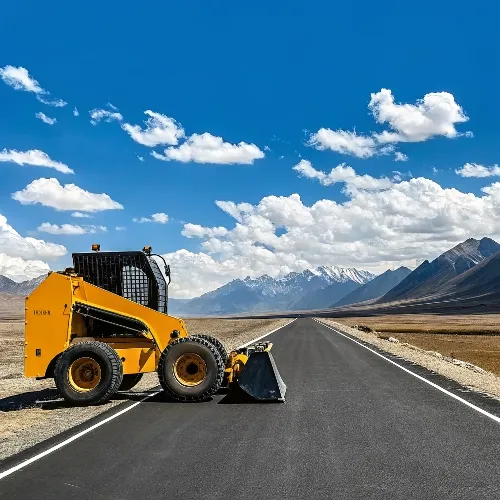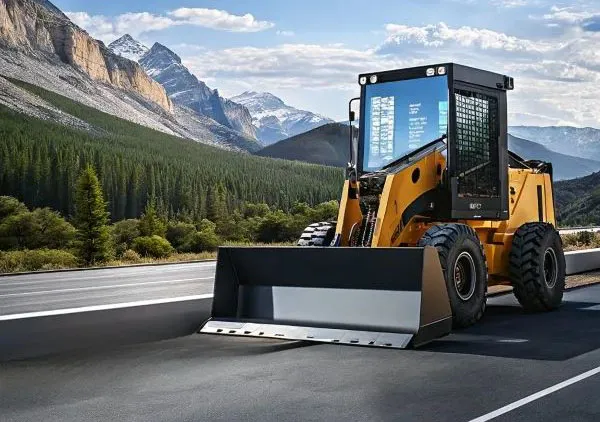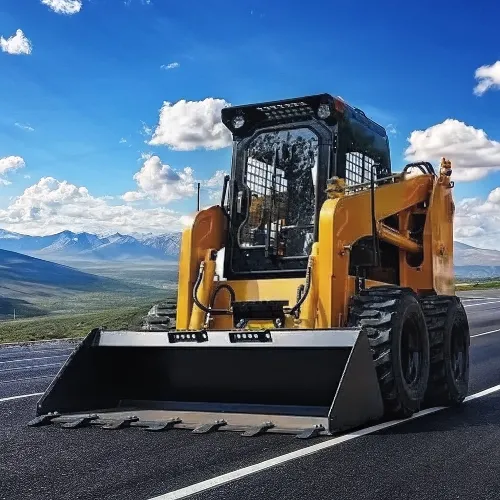Avoid your inquiry is delay response, please enter your WhatsApp/Skype along with the message, so we can contact you at the very first time.
We will reply you within 24 hours. If for urgent case, please add WhatsApp/WeChat: +86 188 0000 0000,. Or call 0086-535-2422021 directly.
*We respect your confidentiality and all information are protected. We will only use your information to respond to your inquiry and will never send unsolicited emails or promotional messages.
I remember my first day on a job site with mud everywhere. I felt worried because our regular machines kept getting stuck in the soft ground. The job site was small and crowded, so large wheel loaders and bulky trucks could not move without constant problems. We needed a machine that was strong enough to handle real loads but small enough to maneuver through tight paths and muddy patches.

My supervisor then introduced me to a Huibang compact wheel loader. At first, I doubted that such a small machine would solve our serious challenges.now I trust compact wheel loaders. I have seen them lift heavy materials and still slip through narrow gaps. They handle moderate mud, especially if the site is partly prepared or the ground is not too swampy. They also move faster on firm soil than a tracked machine, so I can transport loads without slowing down the entire project.
I use compact track loaders when I need a low‑profile workhorse that moves easily in tight spaces. They help me dig, grade, and transport materials without losing traction. Let’s see why people compare them to other loaders and how each type fits different tasks.
I once struggled with large piles of gravel. I needed a loader that could scoop and dump quickly, yet remain stable.
A wheel loader is a machine with wheels, a front‑mounted bucket, and a strong hydraulic system designed to move large volumes of dirt, sand, or other bulk materials.

I see wheel loaders on most construction and landscaping projects. Their big, rugged tires help them travel over packed soil, paved roads, and moderate terrain. I rely on them to move material much faster than manual labor can handle. Operators sit in a raised cab, which lets them view the bucket and the surrounding site.
Wheel loaders shine when I have to fill dump trucks or clear debris in open spaces. I remember a project where we had huge mounds of crushed stone. HuiBang wheel loader finished that loading job in hours, while a smaller loader might have taken days. The combination of a wide bucket and powerful hydraulics helps me scoop large volumes quickly. That speed saves time and money. I can move from one pile to another without changing attachments. I find that wheel loaders often have better travel speed than track loaders on solid ground. That means I can cover more distance between stockpiles with less downtime.
Wheel loaders turn using an articulated steering system. The frame pivots in the middle, so front and rear axles follow the same track. This makes it easier to maneuver in smaller areas than people assume. It’s not as compact as a skid steer, but I rarely have trouble in a mid‑sized construction zone. The tires have decent grip on rough or rocky soil, but I must watch out for slippery mud. If the site is too wet, I might switch to a track loader for better flotation.
Manufacturers build wheel loaders with attachments in mind. Buckets come in various sizes and shapes. Some have teeth for rocky material; some are for snow removal. Quick‑coupling systems let me attach forks or grapples for lifting pallets or logs. That broadens my options. When the site has roads or firm ground, a wheel loader can travel swiftly. It can sometimes replace a backhoe loader for basic digging or backfilling tasks. In many ways, it’s my go‑to machine for bulk handling, stockpile management, or loading tasks on stable terrain.
Wheel loaders use heavy‑duty axles, transmissions, and hydraulics. Routine checks keep them reliable. I monitor tire wear, fluid levels, and pivot points. If I operate on hard ground with heavy loads, I see more tire wear. But tires are easier and cheaper to replace than many track systems. Also, the loader’s strong frame and balanced design handle repeated lifts without major stress. I follow the service schedule, lubricate all points, and watch for fluid leaks. This helps the machine keep its power over thousands of hours.
Wheel loaders work best on ground that is not too soft. If conditions are muddy or swampy, I risk wheel spin or sinkage. Then I either bring in fill material or pick a different machine. When the terrain is workable, a wheel loader is one of my most productive pieces of equipment. I like to think of them as unstoppable bulk movers on stable land.
I typically reserve HuiBang wheel loaders for bigger tasks where I need high load capacity and good travel speed. They remain popular in roadwork, quarries, batch plants, and agricultural settings. A well‑trained operator can get remarkable throughput in a single shift. Even for smaller landscaping tasks, a compact wheel loader can help me transport gravel, soil, or mulch in no time. That reliability is why I keep at least one wheel loader in my fleet.
I have tested many loaders. Each type has benefits, but I want to see if compact wheel loaders can handle tight spaces and still lift enough material.
Compact wheel loaders bring higher speed and lift capacity than smaller skid steers. But they can struggle on very wet or loose soils, and they usually cost more to purchase.

I started using compact wheel loaders when I needed a balance between agility and power. I liked that they had a smaller footprint than full‑size loaders, but still provided decent bucket capacity1. They are not as small as skid steers, so I must plan how they navigate cramped sites. Yet, they do turn well because of their articulated steering. I often see them on landscaping jobs, municipal work, and some mid‑size construction tasks. This machine can hold a respectable amount of material. For instance, a compact wheel loader might have a 1.0 cubic yard bucket, which is enough for moderate projects.
—
Compact wheel loaders usually move faster than track loaders. They can drive on roads if local regulations allow, so I save on hauling costs. That speed helps me transport materials across a job site without slowing production.
The cab on a compact wheel loader sits higher than on most skid steers. I see more of the bucket and the surrounding area. Many cabs have climate control and better ergonomic controls than older machines. This reduces operator fatigue over long shifts.
Although it is a wheel loader, the “compact” size means it weighs less. It exerts less pressure on the ground than a full‑size wheel loader. I can operate on lawns or paved paths with minimal damage if I’m careful.
A compact wheel loader may lift 2,000 to 4,000 pounds or more. That is enough for many palettes of bricks, mulch, or feed. The bucket can hold a considerable amount of material. This extra lifting strength can outclass certain skid steers.
Wheels do not provide the same flotation as tracks. If the site is muddy or has thick clay, a compact wheel loader can sink. I must evaluate ground conditions before committing to this machine.
In many markets, a compact wheel loader is more expensive to purchase than a skid steer of similar power. Maintenance can also cost more, especially if tire replacement and specialized parts are needed. I weigh those costs against the productivity gains.
Articulated steering helps, but it is not as tight as a skid steer’s zero‑turn. If the site has narrow lanes, I might need to maneuver carefully or shift materials in multiple passes. That can slow me down.
Skid steers have a massive range of attachments. Compact wheel loaders do have quick‑attach systems, but the variety is sometimes smaller. However, many mainstream brands offer basic attachments like forks, grapples, and snow blades.
| Feature | Compact Wheel Loader | Skid Steer/Track Loader |
|---|---|---|
| Ground Disturbance | Moderate on stable ground | Lower if on tracks |
| Turning Radius | Good with articulation | Excellent (zero‑turn for skid) |
| Lift Capacity | Higher in many cases | Varied, but can be lower |
| Speed on Pavement | Faster | Slower (tracks or smaller wheels) |
| Attachment Variety | Decent, but less than skid | Often very wide selection |
| Price | Often higher | Often more affordable |
I treat compact wheel loaders2 as a middle ground. They are not as nimble as skid steers, but they move more material per pass. They are not as large or powerful as full‑size wheel loaders, but they bring decent capacity. I find them useful for municipal tasks, small construction projects3, small farms, or landscaping companies that want more lift than a skid steer. I remember a time when I had to move heavy pallets of stone in an upscale neighborhood. The roads were paved, and I needed to move quickly but without tearing up driveways. My compact wheel loader handled the job well. I turned around in narrow cul‑de‑sacs and carried each pallet to the client’s back yard. This machine saved me from renting a larger loader that might have cracked pavement or a skid steer that would have required multiple trips.
I think about the job conditions before choosing a compact wheel loader. If I expect frequent muddy patches or extreme off‑road conditions, I might switch to a track loader. But if the site is firm, and I need speed and a comfortable cab, I select the compact wheel loader. This machine has proven its worth many times. It is more expensive to buy than a smaller loader, but the efficiency gains can justify that investment.
Compact track loaders offer stable traction in wet ground, while wheel loaders move more material on solid terrain. Each loader type delivers unique benefits for different tasks.
Discover the range of bucket capacities available for compact wheel loaders and how they impact project efficiency. ↩
Explore the benefits of compact wheel loaders to understand why they are a great choice for various tasks and projects. ↩
Discover the best equipment for small construction projects to ensure efficiency and effectiveness in your work. ↩